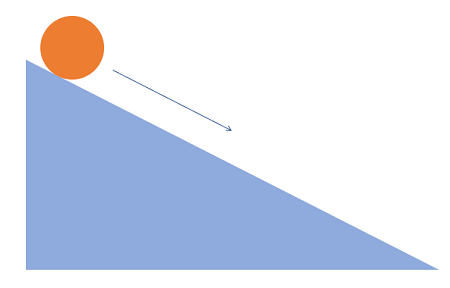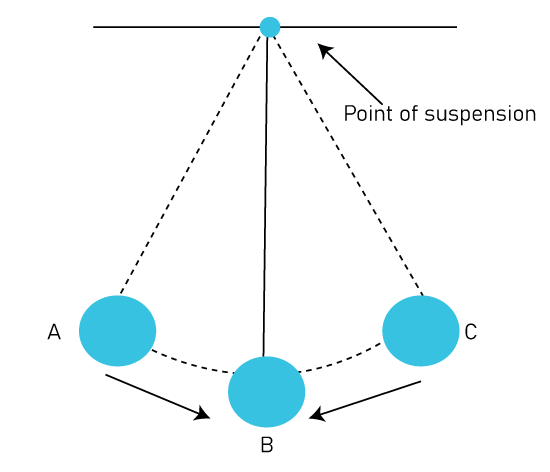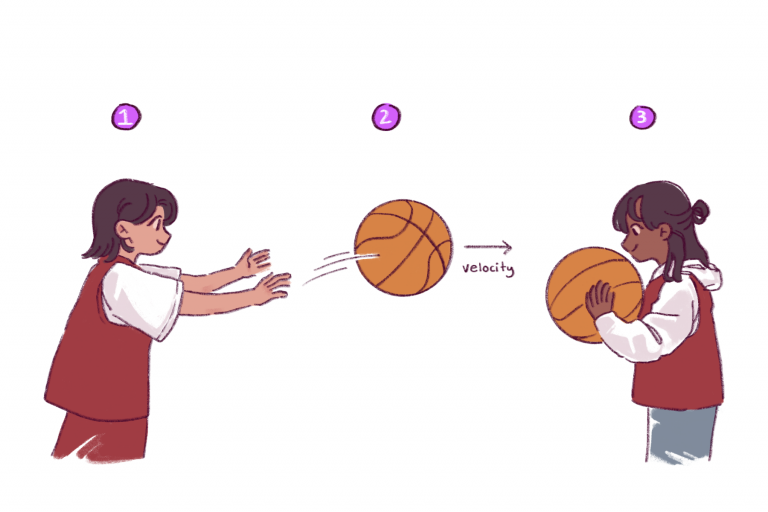An Introduction to Newton’s First Law of Motion
Newton’s First Law of Motion, coined by the renowned scientist Sir Isaac Newton, forms the foundation of classical mechanics. It’s a crucial principle that sheds light on the relationship between an object’s motion and the forces acting upon it.
This law explains the behavior of an object when it’s at rest or in motion. It’s also known as the Law of Inertia, a term that reflects its core concept: an object’s inherent resistance to changes in its state of motion.
Who is Isaac Newton?
Before we delve further into Newton’s first law of motion, let’s take a moment to learn about the person behind this groundbreaking scientific principle – Sir Isaac Newton.
Isaac Newton, born on December 25, 1642, in Woolsthorpe, England, was a renowned mathematician, physicist, and astronomer. He is widely regarded as one of the most influential scientists in history and is credited with establishing the foundations of classical physics.
Newton’s contributions span across various scientific disciplines. In addition to his work on motion and the laws of motion, he made significant advancements in the fields of mathematics, optics, and calculus. His discoveries and theories revolutionized the scientific community and laid the groundwork for future scientific advancements.
Newton’s three laws of motion, published in his book “Mathematical Principles of Natural Philosophy,” are among his most significant contributions. These laws provide a comprehensive framework for understanding the behavior of objects in motion and have become the cornerstone of classical mechanics.
Now that we have a brief understanding of Isaac Newton’s impact on the world of science, let’s dive deeper into Newton’s first law of motion and explore its various aspects.
What is Newton’s First Law of Motion?
Newton’s first law of motion states that an object at rest will stay at rest, and an object in motion will stay in motion with the same speed and in the same direction, unless acted upon by an unbalanced force. In other words, objects have a natural tendency to resist changes in their state of motion. This property is known as inertia.
The first law can be divided into two parts: the behavior of stationary objects and the behavior of moving objects. For stationary objects, the law states that they will remain at rest unless an external force is applied to them. Similarly, for objects in motion, they will continue moving at a constant velocity unless acted upon by an external force.
For those exploring Newton’s first law of motion and its foundational principles, our velocity page offers an essential companion, delving into the crucial relationship between velocity and inertia, enriching the understanding of how objects behave when subjected to external forces as described by Newton’s first law.
Understanding Newton’s First Law of Motion
To understand Newton’s first law of motion, let’s consider a few examples. Imagine a book placed on a table. The book remains at rest until someone applies a force to move it. This is because the book resists changes in its state of motion and tends to “keep on doing what it’s doing” – staying at rest.
Now, let’s think about a moving car coming to a sudden stop. When the brakes are applied, the car decelerates, but the passengers inside continue moving forward due to their inertia. This is why seat belts are crucial for passenger safety, as they provide the unbalanced force necessary to bring them from a state of motion to a state of rest.
Another example is a ball rolling on a flat surface. If there is no friction or external force acting on the ball, it will continue rolling in the same direction and at the same speed indefinitely. This is because the ball’s inertia keeps it moving in the absence of any external interference.
Newton’s First Law of Motion Formula
The formula for Newton’s first law of motion can be expressed as:
F = ma
Where F represents the net force acting on an object, m is the mass of the object, and a is the acceleration. According to the first law, if the net force acting on an object is zero, its velocity will remain constant.
For those exploring the principles of Newton’s first law of motion, our Newton’s second law of motion and Newton’s third law of motion pages serve as insightful companions. Together, they provide a comprehensive understanding of Newton’s laws, elucidating the relationships between force, motion, and the fundamental principles that govern physical interactions in the world of classical mechanics.
Newton’s First Law Of Motion Statement
The statement of Newton’s first law of motion, also known as the law of inertia, can be summarized as follows:
“An object at rest tends to stay at rest, and an object in motion tends to stay in motion with the same speed and in the same direction unless acted upon by an external force.”
This statement encapsulates the fundamental principles of the law. It highlights the idea that objects have a natural tendency to maintain their state of motion or rest. In the absence of external forces, objects will continue moving in a straight line with a constant velocity or remain at rest.
Understanding this statement is crucial for comprehending the behavior of objects and how they respond to external forces. By recognizing the role of inertia and the absence of net forces, we can unravel the mysteries of motion and explain various phenomena in the physical world.
Deriving Newton’s First Law
Newton’s first law of motion, also known as the law of inertia, can be derived from a combination of empirical observations and theoretical reasoning. Isaac Newton developed this law based on his comprehensive study of motion and force.
To derive the first law, Newton analyzed various scenarios and observed the behavior of objects in different situations. He noticed that objects tend to maintain their state of motion or rest unless acted upon by external forces. This led him to formulate the law of inertia, which became the foundation of his entire system of laws.
The derivation of Newton’s first law involves understanding the concept of inertia and the absence of net external forces. Inertia refers to an object’s resistance to changes in its motion, which is directly related to its mass. The greater the mass, the greater the inertia, and the more force is required to change its motion.
Furthermore, Newton recognized that external forces are necessary to cause changes in an object’s motion. In the absence of net external forces, objects will continue moving in a straight line with a constant velocity or remain at rest.
By combining these observations and principles, Newton formulated the first law of motion, providing a comprehensive explanation of how objects behave in the absence of external influences.
Solved Examples of Newton’s First Law of Motion
Let’s explore some examples to further illustrate Newton’s first law of motion:
Uniformly Accelerated Motion
Consider a car accelerating from rest. Initially, the car is at rest, but when the driver applies the gas pedal, an unbalanced force is exerted on the car, causing it to accelerate. This example demonstrates how an object at rest stays at rest until acted upon by an external force.

Uniform Circular Motion
When an object moves in a circular path at a constant speed, it experiences a centripetal force that keeps it moving in a curved trajectory. This force acts towards the center of the circle and prevents the object from moving in a straight line. This example showcases how an object in motion stays in motion with the same speed and in the same direction unless acted upon by an external force.

Harmonic Motion
Harmonic motion refers to the back-and-forth motion of objects, such as a swinging pendulum. Once set in motion, the pendulum continues oscillating due to its inertia. The force of gravity provides the necessary unbalanced force to keep the pendulum in motion.

Objects with Variable Mass
Objects with variable mass, such as rockets, can also be analyzed using Newton’s first law of motion. As the rocket propels itself by expelling mass in the form of exhaust gases, it experiences a reaction force that propels it forward. This example demonstrates how objects with changing mass can still obey the principles of inertia.
Gravitation and Inertia
The concept of inertia also applies to objects in gravitational fields. For example, when an object is thrown upward, it continues to move upward until the force of gravity overcomes its inertia and pulls it back down. This is why objects fall to the ground when dropped – their inertia keeps them moving until an external force, such as gravity, acts upon them.
Inertial Reference Frames
Newton’s first law of motion is applicable within inertial reference frames. An inertial reference frame is a frame of reference in which Newton’s laws hold true. These frames are characterized by uniform motion in a straight line or at rest, with no acceleration or rotation.
Newton’s First Law and Equilibrium
Newton’s first law is closely related to the concept of equilibrium. An object in equilibrium experiences a balanced set of forces, resulting in zero net force and zero acceleration. In this state, the object remains at rest or continues moving with a constant velocity. Equilibrium is a manifestation of Newton’s first law, as the object tends to “keep on doing what it’s doing” when the forces acting upon it are balanced.
What is Force?
Force is a fundamental concept in physics that describes the push or pull experienced by an object. It is measured in Newtons (N) and is typically represented by the symbol F. Force can cause an object to accelerate, decelerate, or change direction. It can also deform or break objects depending on its magnitude and direction.
What Is an External Force?
An external force is a force exerted on an object by an external agent or object. It can change the state of motion of an object by accelerating, decelerating, or changing its direction. Examples of external forces include pushes, pulls, gravity, friction, and air resistance.
Balanced Force
In the realm of Newton’s first law of motion, the concept of balanced force plays a significant role. Balanced force refers to a situation in which the forces acting on an object cancel each other out, resulting in a net force of zero.
When the forces acting on an object are balanced, there is no overall effect on the object’s motion. The object will maintain its state of rest or continue moving with a constant velocity. This is in line with the principles of Newton’s first law, which states that objects at rest tend to stay at rest, and objects in motion tend to stay in motion unless acted upon by an external force.
Balanced forces can arise in various scenarios. For example, when you push a block on a table with the same force that opposes its motion, the forces cancel each other out, resulting in a net force of zero. As a result, the block will remain at rest or continue moving in a straight line with a constant velocity.
In another scenario, consider a book lying on a table. The force of gravity pulls the book downward, while the normal force exerted by the table opposes the force of gravity. When these forces are balanced, the net force is zero, and the book remains at rest on the table.
Understanding balanced forces is crucial for comprehending the principles of Newton’s first law and how objects respond to external influences. By recognizing the conditions under which forces cancel each other out, we can better understand the behavior of objects in various scenarios.
Why is Newton’s First Law of Motion Also Called the Law of Inertia?
Newton’s first law of motion is often referred to as the law of inertia because inertia is the property of matter that Newton’s first law describes. Inertia is the resistance of an object to changes in its state of motion. It is related to the mass of an object, with more massive objects having greater inertia. The first law states that objects tend to “keep on doing what they’re doing” unless acted upon by an unbalanced force, which is a manifestation of inertia.
Everyday Applications of Newton’s First Law
Newton’s first law has numerous applications in everyday life. Here are a few examples:
- When a car comes to a sudden stop, passengers tend to lurch forward due to their inertia. Seat belts provide the unbalanced force necessary to bring passengers to a stop along with the car.
- Objects on a table remain at rest until a force is applied to move them. This is why books, cups, and other objects stay in place unless someone or something moves them.
- When you quickly stop an elevator that is descending, you may feel a sensation of weightlessness as your body continues to move downward due to its inertia.
- A hammer can be used to tighten the head onto a wooden handle by striking the bottom of the handle against a hard surface. The force applied to the handle causes the head to move, but its inertia keeps it moving until it tightens onto the handle.
- When riding a skateboard or bicycle, if you encounter an obstacle that abruptly halts your motion, you may be propelled forward due to your inertia.
Demonstration of Inertia Through Experiments
Inertia can be demonstrated through various experiments. Here are a few examples:
- Place a card on top of a glass with a coin on the card. Quickly remove the card, and you will see that the coin falls straight into the glass. This is because the coin tends to “keep on doing what it’s doing” – staying at rest – even when the card is moved.
- Drop a ball on a slanted surface, and it will roll down the slope due to its inertia. Unless acted upon by an unbalanced force, the ball will continue moving in the same direction and at the same speed.
- When you accelerate a car from rest, items inside the car tend to move backward due to their inertia. This is why objects can fall off the dashboard or slide off the seats when the car accelerates.
What are the Steps to Solve a Problem on Newton’s Laws of Motion?
Solving problems involving Newton’s laws of motion requires a systematic approach. Here are the general steps:
- Identify the forces acting on the object and their directions.
- Determine the net force acting on the object by summing up the individual forces.
- Use Newton’s second law (F = ma) to relate the net force to the mass and acceleration of the object.
- Solve for the unknown quantity (force, mass, acceleration) using algebraic equations.
- Check your solution and ensure it is consistent with the principles of Newton’s laws of motion.
By following these steps, you can successfully solve problems involving Newton’s laws of motion and gain a deeper understanding of the relationship between forces and motion.
What is the Constraint Equation?
A constraint equation describes the relationship between the motion of one body and another body or bodies with which it is interconnected. In other words, it represents the constraints or limitations on the motion of objects in a system. Constraint equations are often used in problems involving multiple bodies or interconnected systems to determine their motion based on the forces and constraints acting upon them.
For example, consider a system consisting of two masses connected by a string passing over a pulley. The constraint equation for this system relates the acceleration of one mass to the acceleration of the other mass and the difference in their masses. By solving this equation, you can determine the motion of the masses in the system.
For readers intrigued by the profound implications of Newton’s first law of motion, our acceleration page serves as a valuable resource, exploring the fundamental connection between acceleration and the response of objects to external forces, providing a deeper understanding of the dynamics inherent in Newton’s groundbreaking principles.
When Does Newton’s First Law Apply to Your Car?
Newton’s first law of motion applies to your car when it is in a state of constant velocity or at rest. When you are driving at a constant speed on a straight road, the net force acting on your car is zero, and it continues moving with the same velocity. Similarly, when your car is parked and not in motion, it remains at rest unless acted upon by an external force, such as another car colliding with it.
However, when you accelerate, decelerate, or change direction, the first law no longer applies. In these cases, the net force acting on your car is not zero, and its motion is determined by the interaction of forces involved, such as the engine power, friction, and air resistance.
In summary, Newton’s first law of motion, also known as the law of inertia, explains how objects tend to “keep on doing what they’re doing” – staying at rest or moving with constant velocity – unless acted upon by an unbalanced force. This law has numerous applications in everyday life and is fundamental to understanding the behavior of objects in motion.
